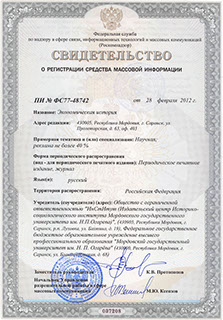Экономическая историЯ
Russian Journal of Economic History
ISSN 2409-630X (Print)
ISSN 2618-916X (Online)
Expert board:
- Scientific Council of RAS on economic history;
- Research and Educational Center «The economic history of Central Russia and the Middle Volga region» of Ogarev Mordovia State University;
- Center of Economic History of Lomonosov Moscow State University
Navigation
Certificate of registration

ISSN 2409-630X (Print), ISSN 2618-916X (Online)
DOI: 10.15507/2409-630X.063.019.202304.328-337
УДК 94:330.8(470.54)
Vasily V. Zapary
Institute of History and Archeology, Ural Branch of the Russian Academy of Sciences (Ekaterinburg, Russia),
e-mail: pantera.zap@gmail.com
Modernization of the Urban Infrastructure of Ekaterinburg – Sverdlovsk in 1923–1930
Abstract
Introduction. The article examines the process of formation and modernization of the urban infrastructure of Ekaterinburg – Sverdlovsk during the period of the New Economic Policy (NEP). The main mechanisms for the development of the urban economy are shown in conditions of regenerative growth of economics and a rapid increase of city’s population. The transformation of Ekaterinburg into Sverdlovsk, the administrative and political center of the Ural region, opened up opportunities to concentrate in it the local community resources and attract government funding. Using of limited market mechanisms of the NEP allowed the Sverdlovsk City Council to develop large infrastructure projects in conditions of moderate co-financing from the state.
Results. Despite the large number of publications on local history, a comprehensive study of the processes of modernization of the urban infrastructure of Sverdlovsk during the NEP period was not carried out. The work analyzes the modernization of the most important sectors of urban infrastructure: electricity, transport, construction, water supply and sewerage. The abolition of command management mechanisms and the permission of private initiative in trade and small industry caused rapid growth in the city’s economy and its population. Sverdlovsk’s status as an administrative and political center of the Ural region strengthened the financial well-being of the city. The Sverdlovsk City Council received large loans from the state-controlled banking system for the development of capital construction and the development of urban infrastructure. By the end of the 1920s in Sverdlovsk, the main elements of modern urban infrastructure were created, water supply, sewerage, bus transit was built, and the construction of a tram system began. In order of regulation of economic activity and city’s property management on market conditions, a communal enterprise was created under the Sverdlovsk City Council – called Komkhoz.
Conclusion. Modernization of the urban infrastructure of Sverdlovsk in 1923–1930 occurred mainly through the efforts of the local community. With the active attraction of local equity capital and loans from state-sanctioned banks, during the NEP period the city began the successful formation of a modern urban infrastructure. The course towards the development of forced industrialization of the USSR through accelerated growth of the public sector of the economy led to the gradual curtailment of private initiative on the ground in 1929–1930.
Keywords: Ekaterinburg, Sverdlovsk, New Economic Policy, urban infrastructure, modernization, Soviet Urals.
For citation: Zapary V. V. Modernization of the Urban Infrastructure of Ekaterinburg – Sverdlovsk in 1923–1930. Ekonomicheskaya istoriya = Russian Journal of Economic History. 2023; 19(4): 327–337. (In Russ.). DOI: 10.15507/2409-630X.063.019.202304.328-337.
Acknowledgements: The research was carried out at the expense of a grant from the Russian Science Foundation № 23-28-01530, https://rscf.ru/project/23-28-01530/.
© Ogarev Mordovia State University. History and Sociology Institute, 2017
68, Of. 411, Bolshevistskaya St., 430005, The editorial office of the scholarly journal «Russian Journal of Economic History»
Tel.: (8342) 24-25-90; 27-07-11, Fax: (8342) 24-25-90, E-mail: jurnal-econom-hist@isi.mrsu.ru
Designed by A. Napalkov, Email: napalkov@isi.mrsu.ru

